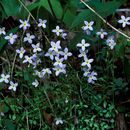Comprehensive Description
provided by North American Flora
Houstonia caerulea L. Sp. PI. 105. 1753
Anonymos ereda Walt. Fl. Car. 86. 1788.
Poiretia ereda J. F. Gmel. Syst. 2: 263. 1791.
Houstonia Linnaei Michx. Fl. Bor. Am. 1: 84. 1803.
Houstonia Linnaei elatior Michx. Fl. Bor. Am. 1: 85. 1803.
Houstonia grandi flora Raf. Ann. G6n. Sci. Phys. 5: 225. 1820.
Houstonia ciliata Raf. Ann. Gen. Sci. Phys. 5: 226. 1820.
Hedyotis caerulea Hook. Fl. Bor. Am. 1: 286. 1833.
Anotis caerulea G. Don, Gen. Hist. 3: 535. 1834.
Hedyotis genlianoides Endl. Ic. Gen. xi. 1840.
Anotis gentianoides Walp. Rep. 4: 230. 1847.
Oldenlandia caerulea A. Gray, Man. ed. 2. 174. 1856.
Houstonia caerulea f. albiflora Millsp. Fl. W. Va. 375. 1892.
Houstonia caerulea Faxonorum Pease & Moore, Rhodora 9: 210. 1907.
Erect perennial, 6-20 cm. high, with long filiform rootstocks, forming dense tufts or mats, the stems very slender, angulate, glabrous, the upper in tern odes longer than the leaves; stipules minute, whitish, naked; leaves crowded at the base of the stem, remote above, the petioles sometimes as long as the blades, the uppermost leaves usually subsessile, the blades mostly spatulate or obovate, sometimes oval, rounded-ovate, suborbicular, or elliptic, 4—12 mm. long, 1-6 mm. wide, rounded to acute at the apex, obtuse to attenuate at the base, thin, hirsutulous or glabrous on the upper surface, glabrous beneath, usually ciliolate; flowers few, terminal and axillary, the pedicels slender, erect, 1.5-7 cm. long; hypanthium about 1 mm. long, glabrous; calyx-lobes linear-oblong, acute, twice as long as the hypanthium or longer, in fruit usually much exceeding the capsule; corolla salverform, violet, blue, or white, with a yellow eye, 8-15 mm. long, the tube slender or very thick, three times as long as the calyx-lobes or longer, the lobes oblong to oval, rounded to acute at the apex, equaling or shorter than the tube; anthers included; capsule subdidymous, about 3 mm. broad, almost half inferior, glabrous; seeds subglobose-crateriform, 0.8 mm. in diameter, dark yellowish-brown, scrobiculate.
Type locality: Virginia.
Distribution: Fields and hillsides, Nova Scotia to Wisconsin, Missouri, Alabama, and Georgia.
- bibliographic citation
- Paul Carpenter Standley. 1918. RUBIALES; RUBIACEAE (pars). North American flora. vol 32(1). New York Botanical Garden, New York, NY
Houstonia caerulea: Brief Summary
provided by wikipedia EN
Houstonia caerulea, commonly known as azure bluet, Quaker ladies, or bluets, is a perennial species in the family Rubiaceae. It is native to eastern Canada (Ontario to Newfoundland) and the eastern United States (Maine to Wisconsin, south to Florida and Louisiana, with scattered populations in Oklahoma). It is found in a variety of habitats such as cliffs, alpine zones, forests, meadows and shores of rivers or lakes.
- license
- cc-by-sa-3.0
- copyright
- Wikipedia authors and editors

